Related Research Articles

The railway system in Great Britain is the oldest railway system in the world. The first locomotive-hauled public railway opened in 1825, which was followed by an era of rapid expansion. Most of the track is managed by Network Rail, which in 2017 had a network of 9,824 miles (15,811 km) of standard-gauge lines, of which 3,339 miles (5,374 km) were electrified. In addition, some cities have separate metro, light rail and tram systems, among them the historic London Underground and the Glasgow Subway. There are also many private railways, some of them narrow-gauge, which are primarily short lines for tourists. The main rail network is connected with that of continental Europe by the Channel Tunnel and High Speed 1, opened in 1994 and 2007 respectively.
British Railways (BR), which from 1965 traded as British Rail, was a state-owned company that operated most rail transport in Great Britain from 1948 to 1997. Originally a trading brand of the Railway Executive of the British Transport Commission, it became an independent statutory corporation in January 1963, when it was formally renamed the British Railways Board.

Transport in the United Kingdom is highly facilitated by road, rail, air and water networks. Transport is a devolved matter with each of the countries of the United Kingdom having separate systems under separate governments.
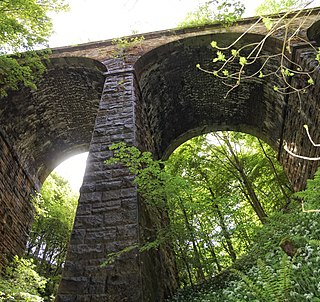
The Beeching cuts, also colloquially referred to as the Beeching Axe, were a major series of route closures and service changes made as part of the restructuring of the nationalised railway system in Great Britain in the 1960s. They are named for Dr. Richard Beeching, then-chair of the British Railways Board and the author of two reports – The Reshaping of British Railways (1963) and The Development of the Major Railway Trunk Routes (1965) – that outlined the necessity of improving the efficiency of the railways and the plan for achieving this through restructuring.

The West Coast Main Line (WCML) is one of the most important railway corridors in the United Kingdom, connecting the major cities of London and Glasgow with branches to Birmingham, Manchester, Liverpool and Edinburgh. It is one of the busiest mixed-traffic railway routes in Europe, carrying a mixture of intercity rail, regional rail, commuter rail and rail freight traffic. The core route of the WCML runs from London to Glasgow for 400 miles (644 km) and was opened from 1837 to 1881. With additional lines deviating to Northampton, Birmingham, Manchester, Liverpool and Edinburgh, this totals a route mileage of 700 miles (1,127 km). The Glasgow–Edinburgh via Carstairs line connects the WCML to Edinburgh. However, the main London–Edinburgh route is the East Coast Main Line. Several sections of the WCML form part of the suburban railway systems in London, Coventry, Birmingham, Manchester, Liverpool and Glasgow, with many more smaller commuter stations, as well as providing links to more rural towns.

The London, Midland and Scottish Railway (LMS) was a British railway company. It was formed on 1 January 1923 under the Railways Act 1921, which required the grouping of over 120 separate railways into four. The companies merged into the LMS included the London and North Western Railway, the Midland Railway, the Lancashire and Yorkshire Railway, several Scottish railway companies, and numerous other, smaller ventures.

Richard Beeching, Baron Beeching, commonly known as Dr Beeching, was a physicist and engineer who for a short but very notable time was chairman of British Railways. He became a household name in Britain in the early 1960s for his report The Reshaping of British Railways, commonly referred to as The Beeching Report, which led to far-reaching changes in the railway network, popularly known as the Beeching Axe.
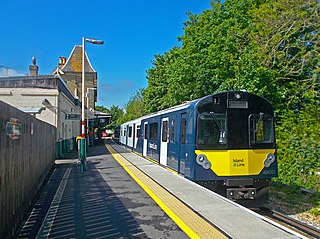
The Island Line is a railway line on the Isle of Wight which runs along the island's east coast and links Ryde Pier Head with Shanklin. Trains connect at Ryde Pier Head with passenger ferries to Portsmouth Harbour, and these ferries in turn connect with the rest of the National Rail network via the Portsmouth Direct Line. The line also connects to the Isle of Wight Steam Railway, a heritage railway, at Smallbrook Junction. For much of its length the line runs alongside the A3055, criss-crossing this road by means of the Ryde Tunnel and bridges at Rowborough, Morton Common, Lake Hill and Littlestairs.

The Hope Valley line is a trans-Pennine railway line in Northern England, linking Manchester with Sheffield. It was completed in 1894.

Haymarket railway station is the second largest railway station in Edinburgh, Scotland, after Waverley railway station.
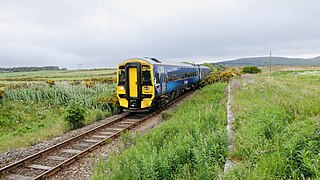
The Far North Line is a rural railway line entirely within the Highland area of Scotland, extending from Inverness to Thurso and Wick. As the name suggests, it is the northernmost railway in the United Kingdom. The line is entirely single-track, with only passing loops at some intermediate stations allowing trains to pass each other. In common with other railway lines in the Highlands and northern Lowlands, it is not electrified and all trains are diesel-powered.
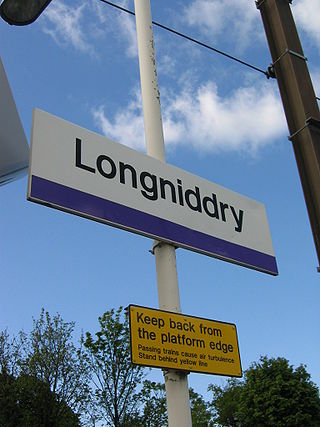
Longniddry railway station is located at the southeast corner of the coastal village of Longniddry, East Lothian, Scotland. The station is on the East Coast Main Line, 13+1⁄4 miles (21.3 km) east of Edinburgh Waverley, and is served by stopping passenger trains on the North Berwick Line.
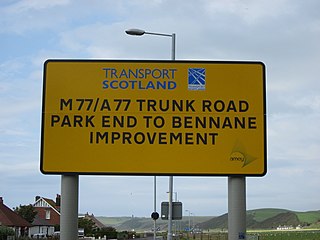
The transport system in Scotland is generally well-developed. The Scottish Government and Scottish Parliament has control over most elements of transport policy within Scotland, with the Cabinet Secretary for Transport, Net Zero and Just Transition holding portfolio responsibility within the Scottish Government. Transport Scotland is the Executive Agency responsible for the Scottish transport network.

The Glasgow Airport Rail Link (GARL) is a proposed link between Glasgow City Centre and Glasgow Airport. The original plans for an airport rail link were proposed during the 2000s to directly link Glasgow Central station with Glasgow Airport in Scotland. The link was intended for completion by 2013 and would have had a service of four trains per hour via Paisley Gilmour Street railway station.

Regional Eurostar was a planned Eurostar train service from Paris and Brussels to locations in the United Kingdom to the north and west of London.

High-speed rail in the United Kingdom is provided on five upgraded railway lines running at top speeds of 125 mph (200 km/h) and one purpose-built high-speed line reaching 186 mph (300 km/h).
The history of rail transport in Great Britain 1948–1994 covers the period when the British railway system was nationalised under the name of 'British Railways', latterly known as British Rail until its eventual privatisation in 1994.
The Wealden Line is a partly abandoned double track railway line in East Sussex and Kent that connected Lewes with Tunbridge Wells, a distance of 25.25 miles (40.64 km). The line takes its name from the Weald, the hilly landscape the lies between the North and South Downs.

Bedlington railway station was a railway station that served the town of Bedlington, Northumberland, England from 1850 to 1964 on the Blyth and Tyne Railway. The station was closed by British Railways in 1964, but construction of a new station is now underway.
Newsham railway station served the village of Newsham near Blyth, England, from 1851 to 1964 on the Blyth and Tyne Railway. It was located at the junction of the Percy Main to Blyth and Bedlington lines of the Blyth and Tyne Railway. The station was closed by British Railways in 1964, but construction of a new station is underway.
References
- ↑ Table 6.1 from Transport Statistics Great Britain (Excel file)
- ↑ Serpell report page 109 (page 112 in the PDF file)
- 1 2 3 4 5 "Sir David Serpell". The Telegraph. 6 August 2008. Retrieved 22 February 2017.
- 1 2 3 Dalyell, Tam (7 August 2008). "Sir David Serpell: Able and influential civil servant". The Independent. Retrieved 6 November 2017.
- ↑ Walker, David (11 August 2008). "Sir David Serpell. High-ranking civil servant known for his 'hatchet job' report into Britain's railways". The Guardian. Retrieved 9 July 2020.
- ↑ Alan Williams Not the age of the train, Ian Allan Ltd (Shepperton) 1983 ISBN 0-7110-1349-7
- 1 2 "The 'bad news' report that helped build today's railway". Railnews. 1 September 2008. Retrieved 18 February 2017.
- ↑ "The fall and rise of Britain's railways: Part 5". RailStaff. 2 October 2013. Retrieved 6 November 2017.
- 1 2 3 Spaven, David (2015). The Railway Atlas of Scotland. Two Hundred Years of History in Maps. Edinburgh: Birlinn. p. 198. ISBN 978-1-78027-238-2.
- 1 2 Rogers, Roy (21 January 1983). "Hostile reception for Serpell options". The Glasgow Herald. Retrieved 15 February 2017.
- 1 2 Rogers, Roy (20 January 1983). "Fresh ingredients that will be unpalatable to the rail industry". The Glasgow Herald. p. 11. Retrieved 10 July 2020.
- 1 2 3 "Sir David Serpell". The Scotsman. 11 August 2008. Retrieved 22 February 2017.
- ↑ Holland, Julian (2015). The Times History of Britain's Railways from 1600 to the Present Day. Glasgow: Times Books. p. 9. ISBN 978-0-00-820478-5.